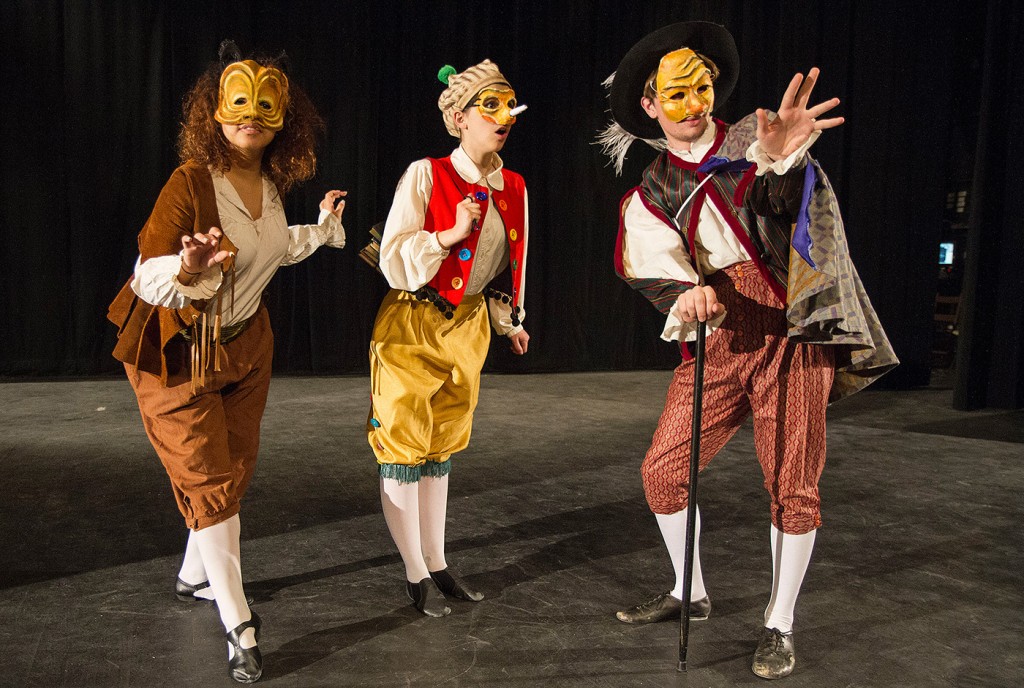VALDOSTA — Valdosta State University Theatre and Dance will help children learn the importance of honesty, love, friendship, hard work, taking responsibility, and other values when it presents “Pinocchio Commedia,” the 2014-2015 season’s Theatre for Young Audiences touring production.
Performances are scheduled for the general public at 7:30 p.m. on Friday, Feb. 6, and 10:30 a.m. on Saturday, Feb. 7, in Sawyer Theatre on the first floor of the Fine Arts Building. Tickets cost $15 for adults, $12 for senior citizens, $10 for children and non-VSU students, and $9 for groups of 10 or more at a single performance, plus tax and a nominal processing fee; they are free for all VSU students with a valid university identification card.
Tickets may be reserved by calling the VSU Theatre and Dance Box Office at (229) 333-5973 between the hours of 2 p.m. and 5 p.m. Monday through Saturday. Cash and check payments only will be accepted this season; there will be no online sales or credit card transactions until further notice.
“Pinocchio Commedia” is Johnny Simon’s commedia dell’arte adaptation of Carlo Collodi’s classic children’s novel, The Adventures of Pinocchio, published in 1883. It is a fresh take on an old favorite, and children of all ages are sure to be captivated and entertained as they watch Pinocchio emerge from a seemingly ordinary block of wood and encounter mischief, magic, and mayhem — like getting turned into a donkey and watching his nose grow every time he tells a lie — on his journey to becoming a real boy.
“Pinocchio’s adventures, made famous by the 1940 movie by Walt Disney, were wild and fantastical with broad characters and unbelievable circumstances,” said Michael Hegarty, director and temporary assistant professor of theatre at VSU. “Commedia is a form of physical theatre that requires an audience’s willing suspension of disbelief. This is not highbrow comedy. Thinking is not required — only your attention and enjoyment.”
Following the weekend’s on-campus performances, VSU Theatre and Dance will kick off its Theatre for Young Audiences area tour, which typically includes 15 to 20 performances at schools, art centers, and so on throughout South Georgia and North Florida. The first stop on this year’s tour is Cook County High School’s Performing Arts Center on Wednesday, Feb. 11. The tour will end on Friday, March 20, in Crisp County.
The goal of the university’s annual Theatre for Young Audiences production, shared Jacque Wheeler, head of the Theatre and Dance Area and professor of theatre, is to expose children in the rural South to live theatrical performances. The touring productions are also an opportunity for VSU to share with the children the importance of post-secondary education.
“The students are excited and engaged by the performances,” she continued. “We provide educational materials for pre- and post-performance activities. Many, many places ask us to return, which speaks to the popularity and educational value of the performances.”
Theatre for Young Audiences productions are primarily geared toward elementary school boys and girls, in kindergarten through the fifth grade.
VSU has a long tradition of serving the kids of South Georgia and North Florida by bringing live theatrical events to them. The College of the Arts has offered Theatre for Young Audiences productions for over 30 years, Wheeler noted.
“We intend to continue the long history of presenting plays for young audiences,” she said. “It is a service to our region and part of our commitment to outreach activities in our community. It also assists in the academic preparation of our Bachelor of Fine Arts students by offering another unique performance opportunity.”
VSU’s Fine Arts Building is located at the intersection of Oak Street and Brookwood Drive.
Contact Jacque Wheeler at (229) 333-5829 or jwheeler@valdosta.edu to learn more Theatre for Youth performances.
Contact Michael Hegarty at (229) 219-1358 or mjhegarty@valdosta.edu to learn more about the touring production.
On the Web:
http://www.valdosta.edu/colleges/arts/communication-arts/theatre-and-dance/
Visit https://www.facebook.com/vstatenews?ref=hl to view more promotional photos and a list of the production’s cast and crew.
Director Michael Hegarty’s Notes on Commedia Dell’Arte
Commedia dell’arte, which is Italian for “play of the professional artists,” is a popular form of theatre that originated during the Italian Renaissance.
Commedia companies typically consisted of 10 members — seven men and three women —who would travel the countryside performing for the masses. Though there were times when they staged serious works, they usually staged comedies, and as a result, commedia dell’arte has come to be associated primarily with comedy.
Commedia flourished in Italy from 1550 to 1750, not as a written form but an improvised one. Members of a company would write short scripts without dialogue, scenarios, which served as an outline of a plot, and then all the lines were improvised on the spot. The conventions of commedia made the actor’s job a bit easier than it might seem. For one thing, no matter what the scenario was, actors always played the same stock characters. They would base their entire careers on perfecting a single stock character. The characters performing “Pinocchio Commedia” are based on stock characters more than 450 years old.
The popularity of commedia dell’arte eventually extended outside of Italy into France, Spain, and England. The historical significance of commedia can be seen in its influence on later theatre. The stock characters, which seem to have grown out of Roman comedy and medieval farce, were further refined by later playwrights like Molière. The comic servant Pulcinella evolved into Punch in the English “Punch and Judy” puppet shows, which appeared in the 18th century and are still performed today. Comparisons can also be made to classic comedy film actors like Charlie Chaplin, Laurel and Hardy, Abbott and Costello, and The Three Stooges. The Marx Brothers used many techniques reminiscent of commedia as well.
Johnny Simon’s idea of adapting Carlo Collodi’s classic 1883 children’s book The Adventures of Pinocchio into a commedia-style play makes perfect sense on so many levels — not just because it is an Italian story, and not just because it features Arlecchino and Pulcinella, two classic commedia stock characters. Pinocchio’s adventures, made famous by the 1940 movie by Walt Disney, were wild and fantastical with broad characters and unbelievable circumstances. Commedia is a form of physical theatre that requires an audience’s willing suspension of disbelief. This is not highbrow comedy. Thinking is not required — only your attention and enjoyment.
Jessica R. Pope
Communications Specialist

